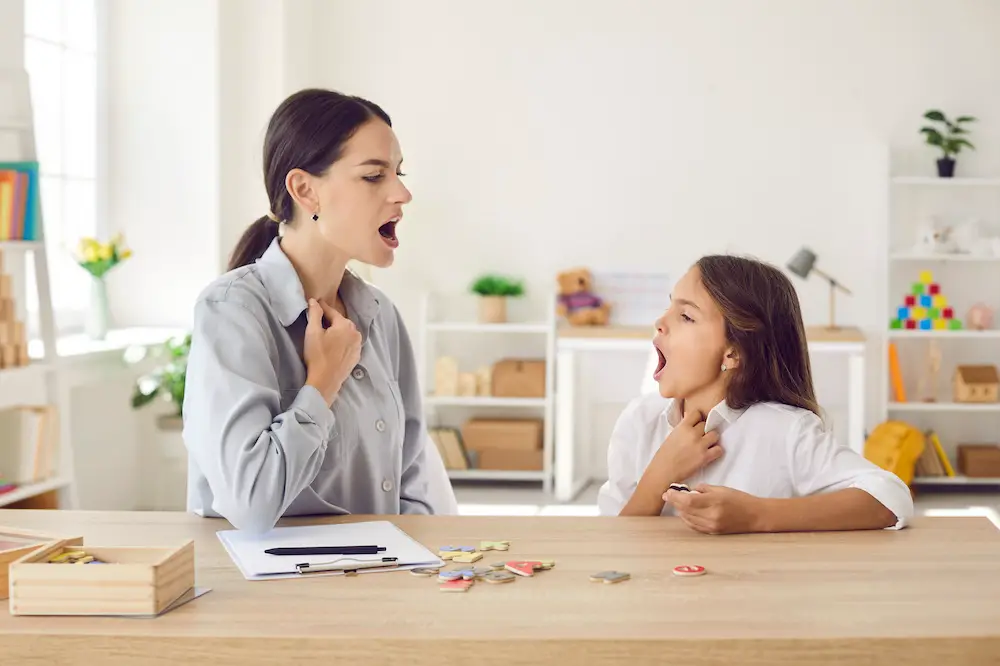Speech development plays a vital role in communication and overall development. However, some individuals experience speech delays or speech sound disorders that can impact their ability to express themselves effectively.
For example, it is crucial to differentiate between articulation vs phonological disorders to provide appropriate intervention.
In this article, we will explore the characteristics, causes, assessment, and treatment of speech sound disorders. By understanding the distinctions between the two, we can better support individuals with speech delays and facilitate their journey toward improved communication skills.
- What Are Articulation Disorders?
- What Are Phonological Disorders?
- Articulation vs Phonological Disorders
- Book Recommendations for Supporting Your Child’s Speech
- Beyond Baby Talk: From Speaking to Spelling: A Guide to Language and Literacy Development for Parents and Caregivers by Kathy Hirsh-Pasek and Roberta Michnick Golinkoff
- It Takes Two to Talk: A Practical Guide For Parents of Children With Language Delays by Lynn Koegel, Ph.D., and Patricia Schreibman, Ph.D.
- FAQs About Articulation and Phonological Disorders
- Navigating Speech Challenges
What Are Articulation Disorders?
An articulation disorder refers to difficulties in producing speech sounds accurately due to problems with the coordination of articulatory muscles.
Individuals with articulation disorders may exhibit difficulties in pronouncing specific sounds or sound patterns. This can lead to unintelligible speech, affecting their oral communication abilities.
Causes and Risk Factors
Articulation disorders can arise from various factors. Some may have a genetic predisposition to speech sound errors, while others may experience delays in their motor skill development, which then affects their ability to coordinate the muscles required for speech sound production.
Environmental factors, such as chronic ear infections or exposure to limited language input, can also contribute to articulation difficulties.
Assessment and Diagnosis
Speech-language pathologists (SLPs) play a crucial role in assessing and diagnosing articulation disorders. Through comprehensive evaluations, including speech sound assessments and analysis of speech samples, SLPs can determine the specific nature and severity of the articulation disorder.
These evaluations may involve standardized tests, informal observations, and interviews with parents or caregivers.
Treatment and Intervention
Early intervention is essential for addressing articulation disorders. SLPs employ various techniques and approaches tailored to the individual’s needs. Therapy may focus on improving specific speech sounds through targeted exercises and practice.
Additionally, SLPs often collaborate with parents and caregivers to provide strategies for reinforcing speech skills in daily activities. Consistent practice and support at home can significantly enhance the effectiveness of speech therapy.
What Are Phonological Disorders?
A phonological disorder involves difficulties with the phonological system, which encompasses the rules and patterns that govern speech sounds in a language.
Unlike articulation disorders that focus on individual sounds, phonological disorders affect the overall sound system, resulting in challenges with phonological patterns, syllable structures, and phonological processes. This can significantly impact intelligibility and the ability to produce age-appropriate speech.
Causes and Risk Factors
Phonological disorders can stem from various factors. Language-based difficulties, such as delays in language acquisition or limited exposure to a rich linguistic environment, can contribute to the development of phonological disorders.
Cognitive factors, such as difficulties with auditory processing or memory, may also play a role. Genetic and familial influences can increase the likelihood of phonological disorders in some cases.
Assessment and Diagnosis
SLPs employ comprehensive assessments to evaluate and diagnose phonological disorders. These assessments involve analyzing the child’s speech sound patterns, phonological processes, and overall intelligibility.
Various tools, including standardized tests, speech samples, and parent interviews, are utilized to gain a holistic understanding of the individual’s phonological abilities and difficulties.
Treatment and Intervention
Intervention for phonological disorders focuses on addressing the underlying phonological patterns and processes. SLPs work with individuals to develop awareness and use of correct sound patterns, emphasizing the generalization of skills across different words and contexts.
Language-focused interventions may also be incorporated to enhance overall communication abilities. Collaborative efforts between SLPs, parents, educators, and other professionals are essential for facilitating consistent practice and supporting the generalization of skills outside of therapy sessions.

Articulation vs Phonological Disorders
Accurate diagnosis is vital for providing appropriate intervention. While these speech sound disorders may share some overlapping features, understanding the distinctions between the two is crucial.
Articulation disorders primarily focus on difficulties with individual sounds, while phonological disorders encompass broader challenges with sound patterns and processes. A comprehensive assessment conducted by a qualified SLP can help differentiate between the two, guiding the development of an effective treatment plan.
Intervention Strategies for Articulation and Phonological Disorders
Intervention strategies for articulation and phonological disorders are tailored to each individual’s unique needs. SLPs create individualized treatment plans based on the specific difficulties identified during the assessment process.
As for activities in speech therapy, they often revolve around improving speech intelligibility and promoting age-appropriate speech production. Collaboration with parents, educators, and other professionals is also vital for implementing strategies in various settings and fostering consistent progress.
Support and Resources for Individuals with Articulation and Phonological Disorders
Individuals with articulation and phonological disorders benefit from a supportive network. It is important to leverage these resources to access information, share experiences, and seek professional help when needed.
For instance, speech therapy resources, both online and offline, provide valuable information and guidance for individuals and their families. Online communities and organizations dedicated to speech delays offer support, advice, and opportunities for connecting with others facing similar challenges.
Book Recommendations for Supporting Your Child’s Speech
Beyond Baby Talk: From Speaking to Spelling: A Guide to Language and Literacy Development for Parents and Caregivers by Kathy Hirsh-Pasek and Roberta Michnick Golinkoff
This book is a comprehensive guide to helping children develop their language and literacy skills. It covers everything from the early stages of babbling and pointing to the more advanced skills of reading and writing.
The authors provide clear and concise explanations of the research on child development, as well as practical advice on how to promote language and literacy learning at home.
How This Book Can Help
One of the strengths of the book is its emphasis on the importance of early exposure to language. The authors argue that children who are exposed to a rich language environment from a young age are more likely to develop strong language and literacy skills.
They provide a number of suggestions for how parents and caregivers can create a language-rich environment. These include reading to children, talking to them about their experiences, and singing songs and rhymes.
Another strength of the book is its focus on the importance of play. The authors argue that play is essential for language and literacy development. They provide a number of suggestions for how parents and caregivers can use play to promote language and literacy learning, such as playing with blocks, dress-up, and make-believe.
Overall, Beyond Baby Talk is an excellent resource for parents and caregivers who want to help their children develop their language and literacy skills. It is well-written, informative, and practical. We highly recommend it to anyone interested in helping their child succeed in school.
It Takes Two to Talk: A Practical Guide For Parents of Children With Language Delays by Lynn Koegel, Ph.D., and Patricia Schreibman, Ph.D.
It Takes Two to Talk is a comprehensive and practical guide for parents of children with language delays. The book is based on the principles of Applied Behavior Analysis (ABA), a scientific approach to teaching that has been shown to be effective in helping children with a variety of developmental delays.
How This Book Can Help
The book is divided into three parts:
- Part I provides an overview of language development and discusses the signs and symptoms of language delays.
- Part II presents a step-by-step guide to teaching children with language delays. The guide covers a variety of topics, including joint attention, requesting, following directions, and using language in different contexts.
- Part III provides resources for parents, including a list of books, websites, and organizations that can provide additional support.
This book is a valuable resource for parents of children with language delays. It is well-written and easy to follow. The authors provide clear and concise explanations of the principles of ABA and how they can be applied to teaching children with language delays.
The book also includes a variety of activities and exercises that parents can use to help their children learn.
It Takes Two to Talk is an excellent resource for parents looking for help with their child’s language development. It is comprehensive, practical, and easy to follow. We highly recommend it to any parent concerned about their child’s language skills.
FAQs About Articulation and Phonological Disorders
1. How can I differentiate between a child’s normal speech development and a potential speech disorder?
It is important to monitor a child’s speech development milestones to identify any potential speech disorders. While variations in speech development are common, certain signs may indicate a need for further evaluation.
If a child consistently struggles with producing a wide range of speech sounds accurately, or if their speech remains unclear and difficult to understand beyond the expected age, it may suggest a speech disorder.
Additionally, if the child’s speech significantly deviates from their peers or if they experience frustration or difficulty communicating, it is advisable to consult a speech-language pathologist (SLP) for a comprehensive evaluation.
2. How can parents and caregivers support a child with articulation or phonological disorders?
Parents and caregivers play a crucial role in supporting children with articulation or phonological disorders. Here are some tips for providing support:
Create a language-rich environment.
Expose the child to a variety of language experiences, including reading books, engaging in conversations, and encouraging verbal expression.
Model correct speech sounds.
Emphasize clear and accurate speech during conversations and provide opportunities for the child to hear and imitate correct pronunciation.
Practice speech exercises and techniques.
Work closely with a speech-language pathologist (SLP) to learn specific exercises and techniques that can help improve speech sounds and patterns. Consistency in practicing these exercises at home can reinforce progress made during therapy sessions.
Foster a positive and supportive atmosphere.
Encourage the child’s efforts and provide constructive feedback. Celebrate small achievements and provide reassurance during challenging moments.
Collaborate with professionals.
Maintain open communication with the child’s SLP and other professionals involved in their care. Seek guidance, ask questions, and actively participate in the child’s therapy sessions to reinforce progress outside of therapy.
Navigating Speech Challenges
Distinguishing between articulation vs phonological disorders is essential for effective intervention and support. By understanding the characteristics, causes, assessment, and treatment approaches for both disorders, we can better assist individuals with speech delays on their journey toward improved oral communication skills.
Early identification, accurate diagnosis, and collaborative efforts between professionals, parents, and caregivers play a vital role in fostering positive outcomes for individuals with articulation and phonological disorders. With the right support and resources, individuals with speech delays can overcome their challenges and achieve successful communication.



